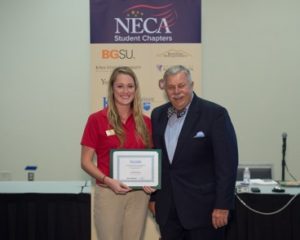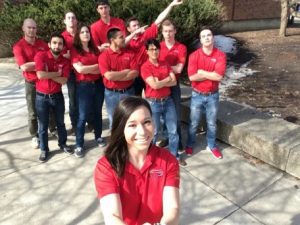 In 2009, a five-person team of students from Iowa State’s civil, construction and environmental engineering department decided to participate in the Green Energy Challenge. The competition, which is sponsored by the ELECTRI International Foundation, challenges student chapters across the nation to create a proposal for sustainable updates to a building in their community.
In 2009, a five-person team of students from Iowa State’s civil, construction and environmental engineering department decided to participate in the Green Energy Challenge. The competition, which is sponsored by the ELECTRI International Foundation, challenges student chapters across the nation to create a proposal for sustainable updates to a building in their community.
The students, who were members of the National Electrical Contractors Association (NECA), chose Edwards Elementary as the subject of their proposal.
Eight years and eight competitions later, the 2016 ELECTRI International Green Energy Challenge team, which is sponsored by the Iowa Chapter NECA, is back at Edwards Elementary, where it all started.
There are a few marked differences between then and now: the team is now 12 members strong (members include: construction engineering seniors Caleb Bonderer, Dylan Busby, Maggie Holt, Bryan Marroquin, Scott Miller, Regan Smiley, and Rick Smith; construction engineering juniors Jack Finn, Tristen Girolamo, Shay Hudachek, and Noah Reddig; and civil engineering junior Heli Nascimento), its officially named Cyclone Energy… and its on a winning streak.
Humble beginnings
When that first group of students began working on its Green Energy Challenge proposal in 2009, the students were focused on assessing sustainability at the Old Edwards Elementary in Ames, Iowa. The facility, which was replaced with a newly constructed building in 2014, contained a number of old systems and equipment that the students had to evaluate.
The ISU group followed the competition’s schedule beginning in January with a request for proposal. All participating teams then complete proposals over the course of a few months, and submit their work in the spring. Proposals are scored over the summer by judges who are members of the electrical contracting industry and members of NECA. At the end of July, the top three written proposals are announced. Winning teams get to give an oral presentation (on the same project) at the NECA National Convention, which occurs in the fall.
“The first year, we got dead last,” Beth Hartmann, advisor for the NECA student chapter, stated. “I think the next year we got next-to-last.”
Things started to look up for the team members once Hartmann got involved. “At first I just let them do the project on their own. But then I thought, why not turn it into a class?”
Her method seemed to work. In 2011 the team placed 5th, and in 2012 the group finally made the top three, with a second-place proposal. That got them a trip to the NECA National Convention in Las Vegas. The oral presentation had four participating schools that year due to a technicality.
“We placed third.”
Not bad, but the team knew it could do better.
Gaining momentum
Margaret Holt, senior in construction engineering, joined the 2013 team. She is the most senior member of the 2016 team.
“I knew absolutely nothing when I first got involved,” Holt recalls. “The juniors and seniors just seemed to get it, and they knew what had to change from previous years.”
Whatever changes they made paid off, because in 2013 the team got 1st place in the written proposal. Holt, along with Hartmann and four other Cyclone Energy team members, travelled to Washington D.C. for the National Convention and the opportunity to give their oral presentation.
“I thought we did really well with the presentation,” Holt said. “But we did terribly at the question-and-answer session.”
Though they can’t say for sure, team members think the questions were what put them in third place.
“It was another learning experience and an opportunity to improve,” Hartmann said.
The following year, in 2014, the team placed 2nd in the written proposal. Then finally, during the trip to the Chicago National Convention, Cyclone Energy got its long-awaited 1st place win.
“I almost cried. I might have actually cried,” Holt said. To add to the emotions, she was also honored with the Best Presenter award, which comes with a $500 cash prize.
“I was supposed to buy the team drinks,” Holt laughed. “I made them all dinner, instead.”

Not ones to get arrogant, the 2015 Cyclone Energy team buckled down for the written proposal that year. Each team member is estimated to have put more than 100 hours of work into the project.
“Personally, I think the proposal we submitted last year was one of the best documents I’ve ever worked on,” Holt said.
Hartmann disagreed. “We put the wrong year on the cover!”
Despite the minor oversight, the 2015 Green Energy Challenge judges tended to agree with Holt. Iowa State’s proposal placed 1st that year. It was announced the last day of July.
“We all wore our NECA polos to work at our internships that day,” Holt recalled. “When we found out, lots of excited snapchats were sent back and forth between team members.”
The 2015 National Convention was in San Francisco. The team put hours into perfecting the presentation – including the question and answer sessions.
Once again, everyone’s hard work paid off.
“We got first place!” Hartmann said. Britta Sortland, a December 2015 civil engineering graduate, won Best Presenter that year.
“I coached her,” Holt stated. “And she still hasn’t bought us drinks.”
Big goals

Now it is 2016. The Cyclone Energy team has come miles from where they started in 2009. And once again they find themselves at Edwards Elementary. What is going to be different this time around?
This year, the subject of the competition is “Eco-School Business Development.” The team will be evaluating the newly constructed Edwards Elementary, and its proposal will include an energy audit of the existing systems, recommendations for improvements, an analysis of the lighting system and suggested updates, and a design for a small solar array with educational capabilities. The proposal will also include a cost estimate, a project schedule and a finance plan.
“We worked with Gerry Peters, the director of facilities planning and management in the Ames School District, to determine what could best benefit the school district,” Holt said. “He’s having us work on an analysis of Edwards Elementary because it’s the first school in the district to be updated. We’re looking at the effectiveness of the systems put in place, and we will make recommendations for what can be improved in future buildings.”
Beyond the proposal, the team is required to work in outreach activities with the school, the community in general and local NECA contractors.
With the team returning to where it all began in its first competition, there’s a different feel going into the work. The students have experience, and they know what it takes to succeed. And there are some (not-so-subtle) expectations: “We want a three-peat,” stated Hartmann.
“We know we can do it, and we’re doing everything we can to make it happen,” Holt said. “It’d be great to keep our streak going while also helping out Ames schools.”
The team is preparing its final submission for its proposal and will find out July 30 how successful it was.
Margaret Holt, senior in construction engineering, contributed to this story.